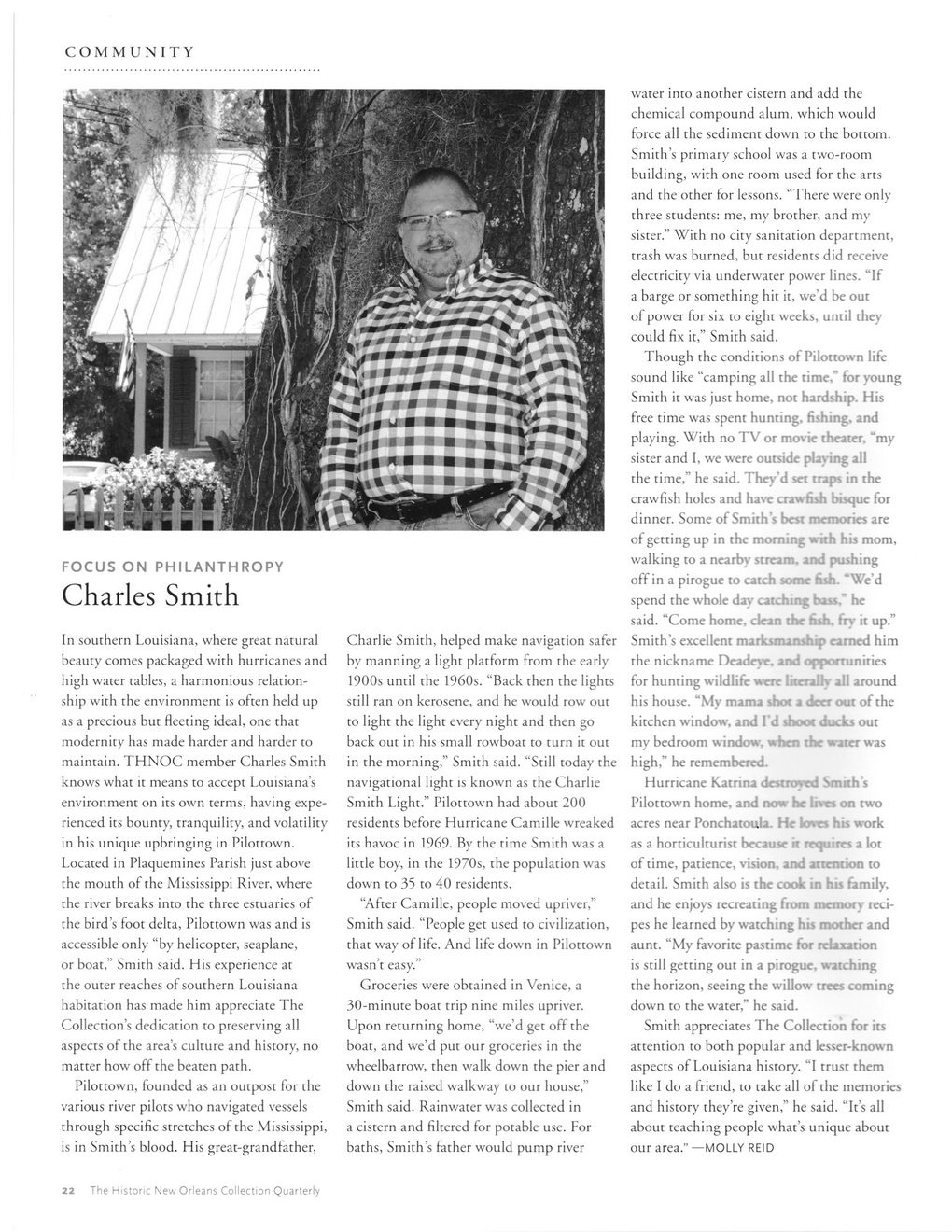This text was obtained via automated optical character recognition.
It has not been edited and may therefore contain several errors.
COMMUNITY FOCUS ON PHILANTHROPY Charles Smith In southern Louisiana, where great natural beauty comes packaged with hurricanes and high water tables, a harmonious relationship with the environment is often held up as a precious but fleeting ideal, one that modernity has made harder and harder to maintain. THNOC member Charles Smith knows what it means to accept Louisiana’s environment on its own terms, having experienced its bounty, tranquility, and volatility in his unique upbringing in Pilottown. Located in Plaquemines Parish just above the mouth of the Mississippi River, where the river breaks into the three estuaries of the bird’s foot delta, Pilottown was and is accessible only “by helicopter, seaplane, or boat,” Smith said. His experience at the outer reaches of southern Louisiana habitation has made him appreciate The Collection’s dedication to preserving all aspects of the area’s culture and history, no matter how off the beaten path. Pilottown, founded as an outpost for the various river pilots who navigated vessels through specific stretches of the Mississippi, is in Smith’s blood. His great-grandfather, Charlie Smith, helped make navigation safer by manning a light platform from the early 1900s until the 1960s. “Back then the lights still ran on kerosene, and he would row out to light the light every night and then go back out in his small rowboat to turn it out in the morning,” Smith said. “Still today the navigational light is known as the Charlie Smith Light.” Pilottown had about 200 residents before Hurricane Camille wreaked its havoc in 1969. By the time Smith was a little boy, in the 1970s, the population was down to 35 to 40 residents. “After Camille, people moved upriver,” Smith said. “People get used to civilization, that way of life. And life down in Pilottown wasn’t easy.” Groceries were obtained in Venice, a 30-minute boat trip nine miles upriver. Upon returning home, “we’d get off the boat, and we’d put our groceries in the wheelbarrow, then walk down the pier and down the raised walkway to our house,” Smith said. Rainwater was collected in a cistern and filtered for potable use. For baths, Smith’s father would pump river water into another cistern and add the chemical compound alum, which would force all the sediment down to the bottom. Smith’s primary school was a two-room building, with one room used for the arts and the other for lessons. “There were only three students: me, my brother, and my sister.” With no city sanitation department, trash was burned, but residents did receive electricity via underwater power lines. “If a barge or something hit it, we’d be out of power for six to eight weeks, until they could fix it,” Smith said. Though the conditions of Pilottown life sound like “camping all the time," for young Smith it was just home, not hardship. His free time was spent hunting, fishing, and playing. With no TV or movie ihcater, “my sister and I, we were outside playing all the time,” he said. They’d set traps in the crawfish holes and have crawfish bisque for dinner. Some of Smith s best memories are of getting up in the morning with his mom, walking to a nearby stream, and pushing off in a pirogue to catch some fish. "We’d spend the whole day catching bus.' he said. “Come home, clean the fish, fry it up.” Smith’s excellent marksmanship earned him the nickname Deadeye. and opportunities for hunting wildlife were literally all around his house. “My mama shot a deer out of the kitchen window, and I'd shoot ducks out my bedroom window, when the water was high,” he remembered. Hurricane Katrina destroyed Smith’s Pilottown home, and now he L\cs on two acres near Ponchatoula. He loves his work as a horticulturist because it requires a lot of time, patience, vision, and attention to detail. Smith also is the cook in hit family, and he enjoys recreating from memory recipes he learned by watching his mother and aunt. “My favorite pastime for relaxation is still getting out in a pirogue, watching the horizon, seeing the willow trees coming down to the water,” he said. Smith appreciates The Collection for its attention to both popular and lesser-known aspects of Louisiana history. “I trust them like I do a friend, to take all of the memories and history they’re given,” he said. “It’s all about teaching people what’s unique about our area.” —MOLLY REID 22 The Historic New Orleans Collection Quarterly

New Orleans Quarterly 2016 Winter (24)